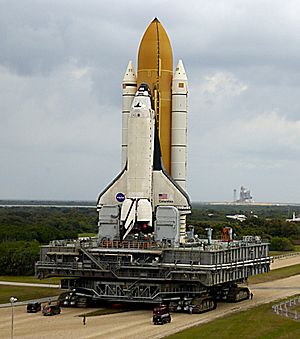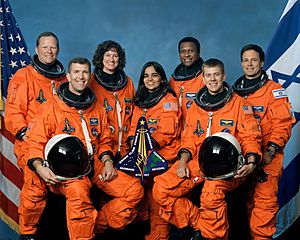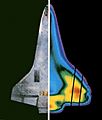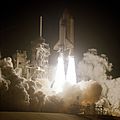Space Shuttle Columbia facts for kids
The Space Shuttle Columbia (OV-102) was a special spacecraft built by NASA. It was designed to fly into outer space and return to Earth, like a plane. Columbia was the very first Space Shuttle to launch into space. This historic flight happened on April 12, 1981.
Sadly, Columbia broke apart when it was coming back into Earth's atmosphere on February 1, 2003. All seven brave people on board died. Before this, the shuttle had completed 28 missions, flying many times into space. The name Columbia came from a U.S. Navy ship that sailed all the way around the world in 1836. It was also the name of the Apollo 11 Lunar Module that landed on the Moon.
Contents
What Caused the Columbia Disaster?
A big problem happened during the launch of Columbia 16 days before the accident. A piece of foam insulation fell off the shuttle's large external fuel tank. This piece of foam hit the left wing of the shuttle.
The impact made a hole in the front edge of the wing. When the shuttle later re-entered Earth's atmosphere, it got extremely hot. Hot gases entered the wing through this hole. These super-hot gases destroyed the inside parts of the wing. This damage caused the rest of the shuttle to break apart in the sky.
Meet the Columbia Crew
Seven astronauts were on board Columbia's final mission, STS-107. They were a team of highly skilled people from different backgrounds. Each person had an important role in the mission.
- Commander: Rick D. Husband was a U.S. Air Force colonel and an engineer. He had flown a shuttle before. He even helped dock a shuttle with the International Space Station.
- Pilot: William C. McCool was a U.S. Navy commander. He was in charge of flying the shuttle.
- Payload Commander: Michael P. Anderson was a U.S. Air Force lieutenant colonel and a scientist. He was responsible for all the science experiments on the mission.
- Payload Specialist: Ilan Ramon was a colonel in the Israeli Air Force. He was the first astronaut from Israel to fly into space.
- Mission Specialist: Kalpana Chawla was an engineer born in India. This was her second trip to space.
- Mission Specialist: David M. Brown was a U.S. Navy captain. He was trained as a pilot and a doctor. Brown worked on many science experiments during the mission.
- Mission Specialist: Laurel Clark was also a U.S. Navy captain and a doctor. Clark focused on biological experiments, studying living things in space.
Columbia's Space Missions
The Space Shuttle Columbia flew 28 missions during its time. Each mission helped us learn more about space and Earth. Here are some of its important flights:
| # | Date | Designation | Launch pad | Landing location | Notes |
|---|---|---|---|---|---|
| 1 | 12 April 1981 | STS-1 | 39-A | Edwards Air Force Base | This was the very first Space Shuttle mission ever. |
| 2 | 12 November 1981 | STS-2 | 39-A | Edwards Air Force Base | This was the first time a crewed space vehicle was used again after its first flight. |
| 3 | 22 March 1982 | STS-3 | 39-A | White Sands Space Harbor | This was the only time a space shuttle landed at White Sands Space Harbor. |
| 4 | 27 June 1982 | STS-4 | 39-A | Edwards Air Force Base | This was the last test flight for the shuttle program. |
| 5 | 11 November 1982 | STS-5 | 39-A | Edwards Air Force Base | This mission had the first four-person crew. It also launched the first commercial satellite. |
| 6 | 28 November 1983 | STS-9 | 39-A | Edwards Air Force Base | This was the first mission with a six-person crew. It also carried the first Spacelab. |
| 7 | 12 January 1986 | STS-61-C | 39-A | Edwards Air Force Base | This was the last successful shuttle flight before the Space Shuttle Challenger disaster. |
| 8 | 8 August 1989 | STS-28 | 39-B | Edwards Air Force Base | This mission launched a KH-11 reconnaissance satellite. |
| 9 | 9 January 1990 | STS-32 | 39-A | Edwards Air Force Base | The crew retrieved the Long Duration Exposure Facility. |
| 10 | 2 December 1990 | STS-35 | 39-B | Edwards Air Force Base | This flight carried several X-ray and UV telescopes. |
| 11 | 5 June 1991 | STS-40 | 39-B | Edwards Air Force Base | This was the 5th Spacelab mission, focusing on Life Sciences. |
| 12 | 25 June 1992 | STS-50 | 39-A | Kennedy Space Center | This mission was the U.S. Microgravity Laboratory 1. |
| 13 | 22 October 1992 | STS-52 | 39-B | Kennedy Space Center | The crew deployed the Laser Geodynamic Satellite II. |
| 14 | 26 April 1993 | STS-55 | 39-A | Edwards Air Force Base | This mission involved German Spacelab D-2 Microgravity Research. |
| 15 | 18 October 1993 | STS-58 | 39-B | Edwards Air Force Base | This was another Spacelab Life Sciences mission. |
| 16 | 4 March 1994 | STS-62 | 39-B | Kennedy Space Center | This mission carried the United States Microgravity Payload-2. |
| 17 | 8 July 1994 | STS-65 | 39-A | Kennedy Space Center | This was the International Microgravity Laboratory (IML-2) mission. |
| 18 | 20 October 1995 | STS-73 | 39-B | Kennedy Space Center | This mission carried the United States Microgravity Laboratory (USML-2). |
| 19 | 22 February 1996 | STS-75 | 39-B | Kennedy Space Center | This mission involved the Tethered Satellite System Reflight. |
| 20 | 20 June 1996 | STS-78 | 39-B | Kennedy Space Center | This was the Life and Microgravity Spacelab (LMS) mission. |
| 21 | 19 November 1996 | STS-80 | 39-B | Kennedy Space Center | This was the longest Shuttle flight at the time. |
| 22 | 4 April 1997 | STS-83 | 39-A | Kennedy Space Center | This Microgravity Science Laboratory mission was cut short. |
| 23 | 1 July 1997 | STS-94 | 39-A | Kennedy Space Center | This was a reflight of the Microgravity Science Laboratory mission. |
| 24 | 19 November 1997 | STS-87 | 39-B | Kennedy Space Center | This mission carried the United States Microgravity Payload (USMP-4). |
| 25 | 13 April 1998 | STS-90 | 39-B | Kennedy Space Center | This was the Neurolab - Spacelab mission, studying the brain in space. |
| 26 | 23 July 1999 | STS-93 | 39-B | Kennedy Space Center | This mission deployed the amazing Chandra X-ray Observatory. |
| 27 | 1 March 2002 | STS-109 | 39-A | Kennedy Space Center | This was a service mission for the Hubble Space Telescope. |
| 28 | 16 January 2003 | STS-107 | 39-A | Did not land (Planned to land at Kennedy Space Center) | This was an Earth science research mission. The Shuttle was destroyed during re-entry on February 1, 2003. All seven astronauts on board died. |
Images for kids
-
Columbia astronauts Thomas K. Mattingly and Pilot Henry Hartsfield salute President Ronald Reagan, standing beside his wife, Nancy, upon landing in 1982.
-
Columbia landing at the SLF Runway 33 following STS-62.
-
Columbia memorial in Arlington National Cemetery
See also
 In Spanish: Transbordador espacial Columbia para niños
In Spanish: Transbordador espacial Columbia para niños











